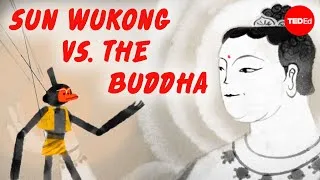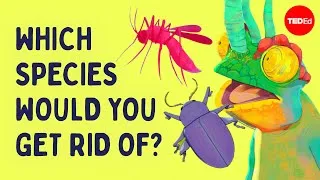Why don’t poisonous animals poison themselves? - Rebecca D. Tarvin
2,581,499 views ・ 2018-07-05
請雙擊下方英文字幕播放視頻。
譯者: Lilian Chiu
審譯者: Helen Chang
00:06
One fine day,
0
6946
1518
這是美好的一天,
00:08
when Charles Darwin was still
a student at Cambridge,
1
8464
3533
查爾斯達爾文還是
劍橋大學的學生,
00:11
the budding naturalist tore some
old bark off a tree
2
11997
4121
這位新進的博物學家
從一棵樹上撕下了一些老樹皮,
00:16
and found two rare beetles underneath.
3
16118
3285
在下面發現了兩隻稀有的甲蟲。
00:19
He’d just taken one beetle in each hand
when he spotted a third beetle.
4
19403
4631
他一隻手拿著一隻甲蟲,
同時看到了第三隻甲蟲。
00:24
Stashing one of the insects
in his mouth for safekeeping,
5
24034
3883
他把其中一隻甲蟲
放到口中以妥善保存牠,
00:27
he reached for the new specimen –
6
27917
2141
接著伸手去抓這隻新樣本——
00:30
when a sudden spray of hot,
bitter fluid scalded his tongue.
7
30058
4808
此時他突然感覺到炙熱的
苦液體噴到他的舌頭上。
00:34
Darwin’s assailant
was the bombardier beetle.
8
34866
3147
攻擊達爾文的,是隻放屁蟲。
00:38
It’s one of thousands of animal species,
9
38013
2342
有數千種像這樣的動物,
00:40
like frogs,
10
40355
855
比如青蛙、水母、
00:41
jellyfish,
11
41210
1007
00:42
salamanders,
12
42217
858
蠑螈,和蛇,
00:43
and snakes,
13
43075
1043
00:44
that use toxic chemicals
to defend themselves –
14
44118
3032
都會用有毒化學物來保衛自己——
00:47
in this case, by spewing poisonous liquid
from glands in its abdomen.
15
47150
5315
在這個例子中,
是從腹部腺體噴出有毒液體。
00:52
But why doesn’t this caustic substance,
ejected at 100 degrees Celsius,
16
52465
5456
但為什麼這種腐蝕性物質
以攝氏一百度的溫度噴出,
00:57
hurt the beetle itself?
17
57921
2443
卻不會傷到甲蟲自己?
01:00
In fact, how do any toxic animals
survive their own secretions?
18
60364
5160
應該問,任何有毒動物是如何
不受自己的分泌物傷害?
01:05
The answer is that they use one
of two basic strategies:
19
65524
3599
答案是,牠們會採用
兩種基本策略的其中一種:
01:09
securely storing these compounds
20
69123
2289
將這些化合物安全存放,
01:11
or evolving resistance to them.
21
71412
3160
或是演化出對抗它們的抗性。
01:14
Bombardier beetles use the first approach.
22
74572
2845
放屁蟲用的是第一種方法。
01:17
They store ingredients for their poison
in two separate chambers.
23
77417
3737
牠們會把毒液的兩種成分
存放在兩個分開的腔室中,
01:21
When they’re threatened, the valve
between the chambers opens
24
81154
3582
當牠們受到威脅時,
兩個腔室間的活門會打開,
01:24
and the substances combine
in a violent chemical reaction
25
84736
3514
這些物質結合起來,
會發生劇烈的化學反應,
01:28
that sends a corrosive spray
shooting out of the glands,
26
88250
3672
導致有腐蝕性的液體從腺體噴出,
01:31
passing through a hardened chamber that
protects the beetle’s internal tissues.
27
91922
4290
噴出過程會通過保護甲蟲
自己內部組織的堅硬腔室。
01:36
Similarly, jellyfish package
their venom safely
28
96212
3744
同樣的,水母也會用
類似魚叉的結構,
01:39
in harpoon-like structures
called nematocysts.
29
99956
3293
叫做刺絲胞,把牠們的毒液
安全地包起來。
01:43
And venomous snakes store their
flesh-eating, blood-clotting compounds
30
103249
4910
毒蛇把其噬肉且會造成
凝血的化合物儲存在
01:48
in specialized compartments
that only have one exit:
31
108159
3726
一個特別的隔間中,
這隔間只有一個出口:
01:51
through the fangs
and into their prey or predator.
32
111885
3759
透過毒牙,進入獵物
或獵食者的身體。
01:55
Snakes also employ the second strategy:
built-in biochemical resistance.
33
115644
6138
蛇也會採用第二種策略:
內建的生化抗性。
02:01
Rattlesnakes and other types of vipers
manufacture special proteins
34
121782
5064
響尾蛇和其他類型的毒蛇
會製造特殊的蛋白質,
02:06
that bind and inactivate venom
components in the blood.
35
126846
5018
能和血液中的毒液化合物
結合並解除毒性。
02:11
Meanwhile, poison dart frogs have also
evolved resistance to their own toxins,
36
131864
5519
箭毒蛙則是演化出了
對自身毒素的抗性,
02:17
but through a different mechanism.
37
137383
1838
但透過的機制是不同的。
02:19
These tiny animals defend themselves
using hundreds of bitter-tasting compounds
38
139221
4993
這些小動物防衛自己的方式,
是使用數百種有苦味的
化合物,叫做生物鹼,
02:24
called alkaloids
39
144214
1665
02:25
that they accumulate from consuming
small arthropods like mites and ants.
40
145879
6153
生物鹼的累積是來自牠們
吃進的小型節肢動物,
如蟎和螞蟻。
02:32
One of their most potent alkaloids
is the chemical epibatidine,
41
152032
3682
牠們最強力的生物鹼之一
是化學地棘蛙素,
02:35
which binds to the same receptors
in the brain as nicotine
42
155714
4120
它和尼古丁所影響到的
大腦接收器是同樣的,
02:39
but is at least ten times stronger.
43
159834
2506
但強度至少強上十倍。
02:42
An amount barely heavier than
a grain of sugar would kill you.
44
162340
5165
只要比一小顆糖還要重的量,
就足以致你於死地。
02:47
So what prevents poison frogs
from poisoning themselves?
45
167505
3566
所以,是什麼讓毒蛙
不會毒死自己的?
02:51
Think of the molecular target
of a neurotoxic alkaloid as a lock,
46
171071
4023
把神經毒生物鹼的
分子標靶想成是一個鎖,
02:55
and the alkaloid itself as the key.
47
175094
2732
生物鹼本身是鑰匙。
02:57
When the toxic key slides into the lock,
48
177826
2292
當有毒的鑰匙插入鎖中時,
03:00
it sets off a cascade of chemical
and electrical signals
49
180118
3995
它就會啟動一連串
化學和電子訊號,
03:04
that can cause paralysis,
50
184113
1759
可能會造成癱瘓、
03:05
unconsciousness,
51
185872
1330
失去意識,
03:07
and eventually death.
52
187202
1737
最終死亡。
03:08
But if you change the shape of the lock,
the key can’t fit.
53
188939
3402
但如果你改變了鎖的形狀,
鑰匙就無法吻合。
03:12
For poison dart frogs and many other
animals with neurotoxic defenses,
54
192341
4876
對毒箭蛙和許多其他
用神經毒來防衛的動物來說,
03:17
a few genetic changes alter
the structure of the alkaloid-binding site
55
197217
4678
一點點的基因改變,
就會轉變結合生物鹼之處的結構,
03:21
just enough to keep the neurotoxin
from exerting its adverse effects.
56
201895
5077
這轉變剛好足讓神經毒素
不要發生有害的作用。
03:26
Poisonous and venomous animals
57
206972
1916
會發展出這種抗性的,
03:28
aren’t the only ones that can develop
this resistance:
58
208888
2945
不只是有毒和分泌毒液的動物:
03:31
their predators and prey can, too.
59
211833
2322
捕食牠們的動物和牠們的獵物也會。
03:34
The garter snake, which dines
on neurotoxic salamanders,
60
214155
3813
襪帶蛇會吃有神經毒素的蠑螈,
03:37
has evolved resistance
to salamander toxins
61
217968
2978
牠們就演化出對蠑螈毒素的抗性,
03:40
through some of the same genetic changes
as the salamanders themselves.
62
220946
4405
演化過程的一些基因改變
是和蠑螈本身一樣的。
03:45
That means that only the most toxic
salamanders can avoid being eaten—
63
225351
4377
那就意味著,只有最毒的
蠑螈才能避免被吃掉——
03:49
and only the most resistant snakes
will survive the meal.
64
229728
3941
且只有抗性最強的蛇
才能在飽餐之後活下來。
03:53
The result is that the genes providing
the highest resistance and toxicity
65
233669
4477
這樣的結果就是,
傳給後代最多的基因,
03:58
will be passed on in greatest quantities
to the next generations.
66
238146
4360
會是能提供最強抗性
和毒性的基因。
04:02
As toxicity ramps up, resistance does too,
67
242506
3325
隨著毒素增強,抗性也會增強,
04:05
in an evolutionary arms race
that plays out over millions of years.
68
245831
5044
這場演化的軍備競賽
已經持續了數百萬年。
04:10
This pattern appears over and over again.
69
250875
3296
這種模式一而再再而三地出現。
04:14
Grasshopper mice resist painful
venom from scorpion prey
70
254171
4345
透過神經系統中的基因改變,
草蜢小鼠能抵抗
來自蠍子的痛苦毒液。
04:18
through genetic changes
in their nervous systems.
71
258516
2779
04:21
Horned lizards readily
consume harvester ants,
72
261295
3334
角蜥能很輕易就吃掉火蟻,
04:24
resisting their envenomed sting
with specialized blood plasma.
73
264629
4624
靠著特殊的血漿,
抵抗牠們有毒的叮螫。
04:29
And sea slugs eat jellyfish nematocysts,
74
269253
3277
海蛞蝓會吃水母刺絲胞,
04:32
prevent their activation
with compounds in their mucus,
75
272530
3381
預防其黏液中的化合物被活化,
04:35
and repurpose them for their own defenses.
76
275911
3152
並將之轉換為牠們
自己的防衛用途。
04:39
The bombardier beetle is no exception:
77
279063
3123
放屁蟲也不例外:
04:42
the toads that swallow them
78
282186
1598
蟾蜍能吞下牠們,
容忍其腐蝕性的噴液,
04:43
can tolerate the caustic spray
that Darwin found so distasteful.
79
283784
4226
也就是讓達爾文非常反感的噴液。
04:48
Most of the beetles
are spit up hours later,
80
288010
2870
大部分的甲蟲在
幾小時之後會被吐出,
04:50
amazingly alive and well.
81
290880
2374
很驚人的是,牠們還是活得好好的。
04:53
But how do the toads
survive the experience?
82
293254
2893
但蟾蜍在這樣的經歷之後
是如何活下來的?
04:56
That is still a mystery.
83
296147
2409
那仍然是個謎。
New videos
Original video on YouTube.com
關於本網站
本網站將向您介紹對學習英語有用的 YouTube 視頻。 您將看到來自世界各地的一流教師教授的英語課程。 雙擊每個視頻頁面上顯示的英文字幕,從那裡播放視頻。 字幕與視頻播放同步滾動。 如果您有任何意見或要求,請使用此聯繫表與我們聯繫。







